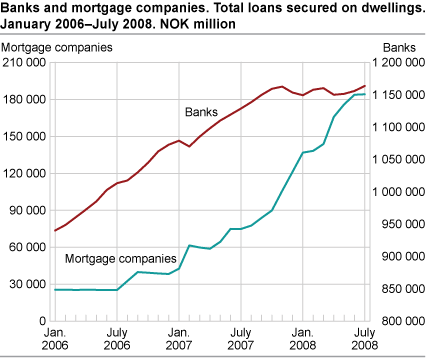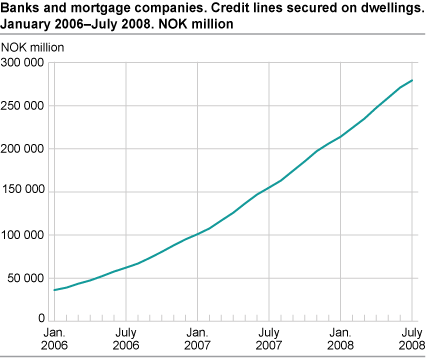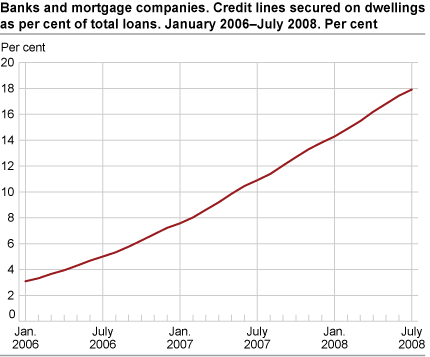Content
Published:
This is an archived release.
Credit lines for housing grows strongly
Loans secured on dwellings issued by mortgage companies and banks to households have increased by 30 per cent since July 2006. Credit lines secured on dwellings have quadrupled in this period and now amounts to 17.9 per cent of total loans to households.
Banks and mortgage companies loans secured on dwellings to households amounted to NOK 1 348 billion at end-July this year. The loan growth was NOK 144 billion, or 12 per cent, compared to July 2007 and NOK 309 billion, or 29.8 per cent, since July 2006.
Credit lines is growing more popular
Credit lines secured on dwellings have increased sharply since the introduction in January 2006. At end-July 2008, credit lines secured on dwellings issued by banks and mortgage companies amounted to NOK 279 billion in total. This is an increase of NOK 125 billion, or 80 per cent, compared to July last year. Credit lines grow quite fast and its share of total loans to households has increased from only 3.1 per cent in January 2006 to 17.9 per cent by end-July this year.
While credit lines secured on dwellings grow strongly and it’s share of total loans increase, the repayment loans secured on dwellings increase more slowly. Repayment loans amounted to NOK 1 068 billion at end-July 2008. This is an increase of almost NOK 20 billion, or 1.9 per cent only, compared to July last year.
Mortgage companies loans increases strongly
Banks loans secured on dwellings amounted to NOK 1164 billion by end July 2008. These loans then increased by NOK 10 billion, or 0.9 per cent, since December last year. In the last twelve months these loans have increased by NOK 34 billion or 3 per cent.
Mortgage companies loans secured on dwellings amounted to NOK 184 billion by end-July 2008, an increase of NOK 63 billion, or 52.1 per cent, since last December and an increase of NOK 109 billion, or 145.3 per cent, since July 2007. The monthly growth in loans secured on dwellings fell to only 0.2 per cent in July, while the monthly growth rate was 15 per cent in April due to portfolio movements of loans from banks to mortgage companies.
Portfolio movements between banks and mortgage companiesLower growth rates in loans issued by banks and increased growth in loans issued by mortgage companies in the same period is largely linked to portfolio movements from banks to mortgage companies. Portfolio movements have become more common as a consequence of the new regulations for bonds with right of priority, which was introduced on 1 June 2007 (see box). The real growth in loans is then not always reflected by looking at each financial institution type in isolation. Bonds with right of priorityA new administrative regulation regarding bonds with right of priority was introduced on 1 June 2007. The regulation applies to mortgage companies issuing bonds with right of priority secured in a portfolio of public loans and loans secured on dwellings. The bonds are often named “housing bonds” because they are secured in a housing mortgage portfolio and have priority over other types of debt. Several mortgage companies issue such bonds now, and more have indicated that they may issue such bonds in the future. |
The statistics is now published as Banks and mortgage companies.
Contact
-
Statistics Norway's Information Centre
E-mail: informasjon@ssb.no
tel.: (+47) 21 09 46 42



